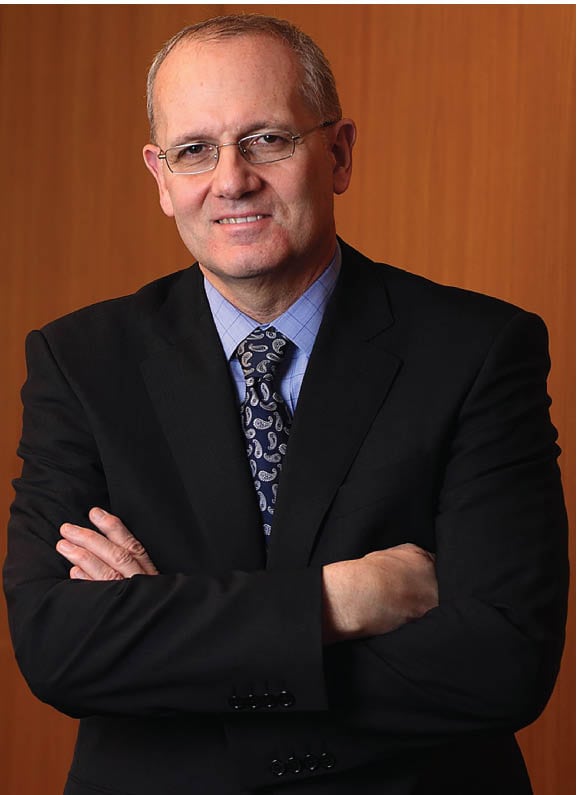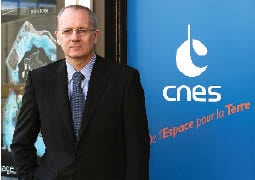Latest News

Jean-Yves Le Gall is one of the most recognizable faces in the global satellite industry. The industry veteran, and former Satellite Executive of the Year Award recipient, is getting to grips with a new role as the President of the Centre National d’Etudes Spatiales (CNES), which plays a key role in shaping space policy in France. He was appointed in April of last year and is coming up to his first 12 months in the role.
We meet on a cold Saturday morning in London. I am eager to find out how Jean-Yves Le Gall is adapting to his new role. My timing is impeccable as SpaceX has just launched its first commercial satellite. Given the verbal jousting that used to take place between Le Gall and SpaceX’s President Gwynne Shotwell at previous satellite events, I cannot resist the opportunity to get his views on SpaceX and the impact this could have on Arianespace as well as the Ariane 6 project, which is something CNES is heavily involved in. Le Gall surprises me by starting with a compliment, calling SpaceX’s achievement “very impressive.”
“[SpaceX] has a very good technical team as well as the opportunity to launch back-to-back satellites. It is clear with SpaceX coming into the market that we will have to meet this challenge. Of course, we have to evolve with the competition, but Europe has been very successful over the last 10 years. It is our job to meet this challenge. We have to adapt the way we have in the past. The key point is that we are adapting and that is why we are pushing so hard with Ariane 6. Our objective is to have a competitive launch vehicle, and I think we can have a launch vehicle with what it is on the market today,” he says.
When Le Gall mentions “we,” I have to remember he is no longer the CEO of Arianespace, but it is clear, whether for CNES or Arianespace, a marker has been put down. Given Arianespace’s dominance in the launch market and its ability to launch often and reliably, the next few years should be fascinating for observers of the launch market. A lot is riding on the Ariane 6 project.
November 2012
Le Gall first heard about the possibility of joining CNES after the European Ministerial Meeting in November 2012. After building up Arianespace as a world-class launch service provider, he admits it was time to face a new challenge. Creating a legacy and shaping the future were key attractions to the new position.
“In my previous job, I was in charge of a cycle of action. The big difference with CNES is that I am in charge of long-term action. With Arianespace, it was more about the day-to-day activity. With CNES, I have to work on getting the support of member states. I am not really in charge of day-to-day activities here,” he says. “We are working on long-term strategies and gaining support. At Arianespace, I really did not get involved in politics at all, where it is part of life on a day-to-day basis with CNES. A lot of my job at CNES revolves around explaining our long-term objectives to a political audience.”
It is clear the world is changing, and Le Gall admits he has to change with it, saying one of the challenges of the new role is the pace of it. To highlight the point, Le Gall talks about bringing the Ariane 6 rocket to market in record time. “I have been very fortunate to be in Arianespace over the last 10 years,” he says. “The most interesting part of my job now is I have to move faster and faster. It is exciting and challenging to be like this. Ariane 5 was decided back in 1985, with a first flight in 1995 and then commercially it was in the market in 2000. That seems very comfortable. We are looking to launch Ariane 6 in 2020, so in just 6 years. What this means is that the process to bring the Ariane 6 to market is twice as fast as it was with Ariane 5.”
 Given that we are now in much more difficult economic times, this adds an extra layer of complexity to the challenge. “If you look at the situation 25 years ago with Ariane 5, the economic conditions were more favorable. When you look at the Ariane 6 project, there is far greater competition in the launch market. But in the current economic environment we need to create something that makes sense economically and is affordable. You have to factor in things such as the cost of labor, and this creates challenges for us,” Le Gall says.
Given that we are now in much more difficult economic times, this adds an extra layer of complexity to the challenge. “If you look at the situation 25 years ago with Ariane 5, the economic conditions were more favorable. When you look at the Ariane 6 project, there is far greater competition in the launch market. But in the current economic environment we need to create something that makes sense economically and is affordable. You have to factor in things such as the cost of labor, and this creates challenges for us,” Le Gall says.
However, while the speed of change is now noticeably faster than in previous times, Le Gall believes he went to CNES at the right time. “At Arianespace, I was able to help bring in Ariane 5 and develop the Vega rocket. I think life in the next 10 years at CNES will be very exciting as the last 10 years in Arianespace had been very exciting. We had introduced Ariane 5, Soyuz and Vega into the market. I think the next 10 years are going to be very interesting in CNES with the development of Ariane 6,” he adds.
Whereas the day-to-day job was all about launching rockets successfully for Arianespace the key challenge for Le Gall this year will be the European Ministers Conference, which will take place later this year and could shape European space policy for many years to come. Outlining the key objectives for this meeting, Le Gall says, “We have three points on the agenda: launchers, the relationship between ESA and EU, and the Space Station. If we have a success in Luxembourg, for me it would represent a good start for my role in CNES.”
Earth Observation and Alliances
One of the other interesting challenges about this new role for Le Gall is working in different areas of the space industry. For example, shaping France’s policy in terms of Earth observation is another key challenge. “We have Pleiades, our Earth observation program,” says Le Gall. “We have two satellites that are in orbit today. We are working on what we call the post-Pleiades program … A decision will be taken in the next four to five years. We are already working on this. This program will be only done by France, there are no plans to collaborate with other countries with this; it is clear a new program is the next step. The two satellites that are in orbit will have to be replaced in eight to nine years.”
Another key part of the job is building alliances with other countries while supporting French interests internationally. Le Gall says he has been impressed by the United Kingdom’s decision to dramatically increase its contribution to the European Space Agency (ESA) by 30 percent. Le Gall mentions that CNES is close to signing a framework agreement with the U.K. Space Agency, in what he calls “an exciting development.”
“In terms of partnerships, we are preparing the next steps with Japan and China. We have a cooperation with NASA around Mars exploration, and we have also signed a contract this year with ESA regarding developing future launchers. With China, we have a few satellites under development. There is a lot of work going on in terms of partnerships … I spend a big part of my time visiting with my European counterparts, with countries such as the United Kingdom and Germany, for example. We are also talking to the United States, Asia, China, India and Japan,” he says.
After a wide-ranging discussion on Ariane 6, Earth observation, SpaceX, international partnerships and politics, I take my leave. It is clear that Le Gall is relishing his new role, but the challenges are many. As he admits himself, the first key successes in his new role will likely come later this year at the European Ministers Meeting. It could be an early defining point in his role at CNES. VS
Get the latest Via Satellite news!
Subscribe Now